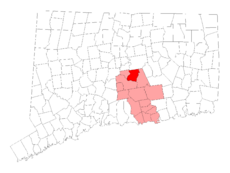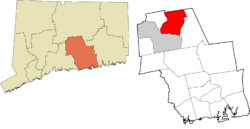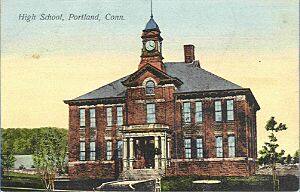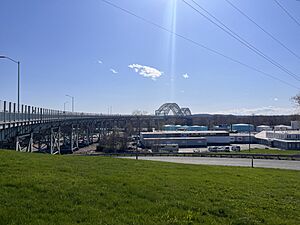Portland, Connecticut facts for kids
Quick facts for kids
Portland, Connecticut
|
||
|---|---|---|
| Town of Portland | ||

Main Street in Portland facing toward the town hall
|
||
|
||
| Nickname(s):
Quarry Town
|
||
 Middlesex County and Connecticut Middlesex County and Connecticut |
||
| Country | ||
| U.S. state | ||
| County | Middlesex | |
| Region | Lower CT River Valley | |
| Incorporated | 1841 | |
| Government | ||
| • Type | Selectman-town meeting | |
| Area | ||
| • Total | 64.5 km2 (24.9 sq mi) | |
| • Land | 60.6 km2 (23.4 sq mi) | |
| • Water | 3.8 km2 (1.5 sq mi) | |
| Elevation | 48 m (157 ft) | |
| Population
(2020)
|
||
| • Total | 9,384 | |
| • Density | 154.9/km2 (401/sq mi) | |
| Time zone | UTC-5 (Eastern) | |
| • Summer (DST) | UTC-4 (Eastern) | |
| ZIP code |
06480
|
|
| Area code(s) | 860/959 | |
| FIPS code | 09-61800 | |
| GNIS feature ID | 0213491 | |
| Website | http://www.portlandct.org/ | |
Portland is a town in Middlesex County, Connecticut, United States. It is part of the Lower Connecticut River Valley Planning Region. In 2020, about 9,384 people lived here. The main part of town is also known as a census-designated place (CDP). Portland is located across the Connecticut River from Middletown.
Portland is famous for its brownstone, a type of reddish-brown sandstone. This stone was used to build many important buildings. For example, Hartford's Old State House was built with Portland brownstone in 1796. Many buildings at Wesleyan University and Trinity College also feature this stone. Even some famous brownstone buildings in New York City used stone from Portland's quarries. One of the old quarries has even been turned into an adventure park! In summer, you can enjoy zip lines, cliff diving, and scuba diving there.
The Connecticut River forms about half of Portland's border. The town has eight marinas and boat clubs, which are great for water activities. There are also three 18-hole golf courses for sports lovers.
Contents
History of Portland
Early Days and Native Americans
Before European settlers arrived, the Wangunk tribe lived in this area. They continued to live in Portland even after settlers came. Their name, "Wangunk," refers to the bend in the Connecticut River that wraps around half of the town.
Settlers and the Brownstone Boom
The first European settlers came to Portland in the 1690s. They were drawn by the valuable brownstone. This stone was used for building homes and even gravestones. Because the town was right on the river, the stone could be shipped far away. Portland's brownstone quarries supplied stone to New York, Boston, and even places as far as San Francisco, Canada, and England.
By the 1850s, over 1,500 people worked in the quarry business. More than 25 ships carried the stone. Later, shipbuilding became very important, and the town's economic center moved to the Gildersleeve area. Many immigrants came to Portland to work in the quarries. First, people came from Ireland, then Sweden, and later, Italy.
Portland was originally part of Middletown and was called East Middletown. In 1767, Chatham was formed, which included Portland and East Hampton. Portland became its own separate town in 1841. Its name comes from Portland, England, which was also known for its stone quarries.
Portland's Oldest Church
The First Congregational Church is the oldest church in Portland. In 1710, people met to plan a building for preaching. The Connecticut General Assembly approved "parish privileges" in 1714. After some debate, they chose a spot for the new "Third Ecclesiastical Society of Middletown" meetinghouse at "Hall Hill." The first pastor, Rev. Daniel Newell, started his work on October 25, 1721. In 1843, the society's name changed to the "First Ecclesiastical Society of Portland."
Later Years: Shipbuilding and Industry
Before quarrying became the main industry in the 1800s, Portland was known for shipbuilding. The Gildersleeve family, famous shipbuilders, lived in the Gildersleeve village. The first ship built in Portland was launched in 1741. During the American Revolution and the War of 1812, many U.S. Navy ships were built in Portland's shipyards.
In the late 1800s, other goods like tinware and enamelware were made in town. Tobacco farming was also a big industry. During the American Civil War, more ships were built in Portland, including the steamship USS Guard (1857) and the bark USS J. C. Kuhn (1859).
The Public Library Story
In 1895, Portland decided to open a public library. Before this, private libraries had been around for over a century. The Portland Library started as a room in Town Hall with about 800 books. These books came from the private Portland Library Association.
Soon after, Horace B. Buck, a Portland native, gave $2,000 to build a separate library building. The town added another $1,000. Shaler & Hall and Brainerd Quarries donated the brownstone. Before the building was finished, Buck gave another $500. After he passed away, his estate gave $2,500 more. The library moved to a new building in 1981.
End of an Era
In the early 1900s, brownstone became less popular as concrete became common. The brownstone industry began to decline. In 1936, a big flood on the Connecticut River filled the quarries, which effectively ended the brownstone industry in Portland. Shipbuilding also stopped around this time.
Education in Portland
The Portland Public School District has four schools. They serve a total of 1,425 students.
How Schools Began
In the early 1700s and 1800s, schools were run by "school societies." These societies were replaced when the first Board of Education was chosen in 1856. The area was then divided into different school districts.
Past and Present School Buildings
- Gildersleeve School: Gildersleeve Hall, in District 1, was built in 1876 on Main Street. It taught both elementary and high school students. It was the first high school in any Connecticut town. A fire destroyed it in 1889, but it was rebuilt in the same spot. It stopped being a high school in 1899 but continued as a school until 1958. The current Gildersleeve School opened in 1964 at 575 ½ Main Street. It now serves students in grades 3 and 4.
- Central School Building (Town Hall): Central School District, District 2, had several schools from 1830 to 1979. The only building left is the Central School Building at 33 East Main Street. It is now the Town Hall. This building was first called Portland High School and offered high school classes in 1890. It became part of Gildersleeve High School in 1899. It remained a school until 1979 and became the Town Hall in 2001.
- Other Early Schools:
- District 3's Rose Hill School was the first school building in Portland. It was used until 1936 and is now a private home.
- District 4's Penfield Hill School (1830–1920) is now owned by Noyes School.
- District 5's Up City School (1857–1921) on Glastonbury Road is now a home.
- District 6's Pecausett School (1830–1911) was at the corner of Grove Street and East Hampton Road.
- District 7's Bucktown School (1830–1872) was on the eastern end of Cotton Hill Road.
- Brownstone Intermediate School: This school, at 314 Main Street, opened in 1932 as the Junior-Senior High School for grades 7–12. It was updated in 1953 and 1967. In 1960, it was renamed Portland Junior High School. In 1989, it became Portland Middle School for grades 6-8. Since 2004, it has been the Brownstone Intermediate School, serving grades 5 and 6.
- Valley View Elementary School: Located at 81 High Street, Valley View Elementary School opened in 1954. An addition was finished in 1958. Valley View currently teaches students in kindergarten through grade 2.
- Portland High School & Middle School: Portland High School, at 95 High Street, opened in 1960 as the new Senior High School. A large addition was completed in 1969. More updates and a second addition were finished in 2004. This project included a large new building for the Portland Middle School at 93 High Street, which houses grades 7 and 8.
Geography and Climate
Portland covers about 24.9 square miles (64.5 square kilometers). About 23.4 square miles (60.6 square kilometers) is land, and 1.5 square miles (3.8 square kilometers) is water. The main town center, also a CDP, covers about 5.5 square miles (14.2 square kilometers). The village of Gildersleeve is also part of Portland.
| Climate data for Portland, Connecticut | |||||||||||||
|---|---|---|---|---|---|---|---|---|---|---|---|---|---|
| Month | Jan | Feb | Mar | Apr | May | Jun | Jul | Aug | Sep | Oct | Nov | Dec | Year |
| Record high °F (°C) | 70 (21) |
74 (23) |
86 (30) |
93 (34) |
99 (37) |
100 (38) |
101 (38) |
102 (39) |
101 (38) |
89 (32) |
83 (28) |
75 (24) |
102 (39) |
| Mean daily maximum °F (°C) | 36 (2) |
39 (4) |
48 (9) |
60 (16) |
70 (21) |
79 (26) |
84 (29) |
82 (28) |
75 (24) |
63 (17) |
52 (11) |
41 (5) |
61 (16) |
| Mean daily minimum °F (°C) | 18 (−8) |
22 (−6) |
29 (−2) |
40 (4) |
49 (9) |
59 (15) |
65 (18) |
63 (17) |
54 (12) |
42 (6) |
35 (2) |
24 (−4) |
42 (5) |
| Record low °F (°C) | −17 (−27) |
−24 (−31) |
−4 (−20) |
11 (−12) |
25 (−4) |
39 (4) |
45 (7) |
38 (3) |
29 (−2) |
18 (−8) |
5 (−15) |
−12 (−24) |
−24 (−31) |
| Average precipitation inches (mm) | 3.15 (80) |
2.75 (70) |
3.57 (91) |
3.88 (99) |
3.89 (99) |
3.99 (101) |
4.00 (102) |
3.66 (93) |
3.48 (88) |
4.14 (105) |
3.84 (98) |
3.35 (85) |
43.7 (1,111) |
Population and People
| Historical population | |||
|---|---|---|---|
| Census | Pop. | %± | |
| 1850 | 2,836 | — | |
| 1860 | 3,657 | 28.9% | |
| 1870 | 4,693 | 28.3% | |
| 1880 | 4,157 | −11.4% | |
| 1890 | 4,687 | 12.7% | |
| 1900 | 3,856 | −17.7% | |
| 1910 | 3,425 | −11.2% | |
| 1920 | 3,644 | 6.4% | |
| 1930 | 3,930 | 7.8% | |
| 1940 | 4,321 | 9.9% | |
| 1950 | 5,186 | 20.0% | |
| 1960 | 7,496 | 44.5% | |
| 1970 | 8,812 | 17.6% | |
| 1980 | 8,383 | −4.9% | |
| 1990 | 8,418 | 0.4% | |
| 2000 | 8,732 | 3.7% | |
| 2010 | 9,508 | 8.9% | |
| 2020 | 9,384 | −1.3% | |
| U.S. Decennial Census | |||
In 2000, Portland had 8,732 people living in 3,388 households. About 2,419 of these were families. The population density was about 373 people per square mile. Most residents (95.12%) were White. About 2.44% were Black or African American. Other groups made up smaller percentages.
About 33.6% of households had children under 18. Most households (58.5%) were married couples. About 24.1% of households were single people. The average household had 2.52 people. The average family had 3.01 people.
The median age in Portland was 39 years old. About 25.5% of the population was under 18. About 14.6% were 65 or older. For every 100 females, there were about 95 males.
The median household income was $63,285. The median family income was $73,036. About 5.1% of the population lived below the poverty line. This included 4.6% of those under 18 and 8.9% of those 65 or older.
Town Center Population
In 2000, the Portland town center (CDP) had 5,534 people in 2,225 households. The population density was about 1,121 people per square mile. Most people (93.89%) were White. About 3.22% were Black or African American.
About 29.8% of households had children under 18. The median age in the town center was 40 years. About 6.7% of the population in the town center lived below the poverty line.
Places to See in Portland
- Arrigoni Bridge: This large bridge connects Portland and Middletown, Connecticut across the Connecticut River.
- Portland Brownstone Quarries: These historic quarries are a National Historic Landmark. Today, they are known as "Brownstone Exploration and Discovery Park." It's a fun place for zip-lining and water activities.
- Providence & Worcester railroad bridge: This railroad bridge was featured in the music video for Billy Joel's 1993 song "The River of Dreams."
- Williams and Stancliff Octagon Houses: These unique eight-sided houses are located at 26 and 28 Marlborough Street. They were added to the National Register of Historic Places in 1976.
Famous People from Portland
- Erin Brady (born 1987), a beauty queen who was crowned Miss USA in 2013.
- Oscar Hedstrom (1871–1960), who helped start the Indian Motorcycle Company. He lived in Portland and is buried here.
- Joey Logano (born 1990), a champion NASCAR driver.
- John Hall Sage (1847–1925), a well-known expert on birds (ornithologist).
Images for kids
See also
 In Spanish: Portland (Connecticut) para niños
In Spanish: Portland (Connecticut) para niños













